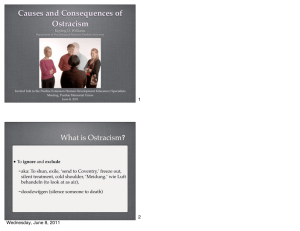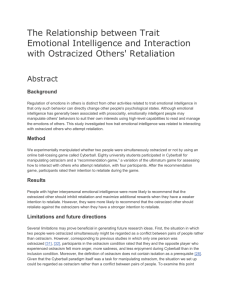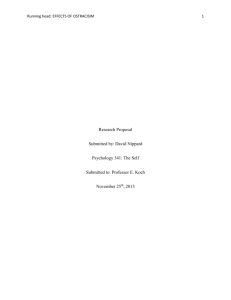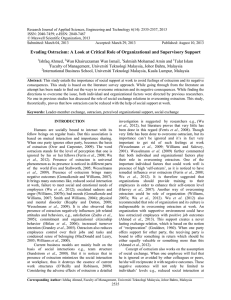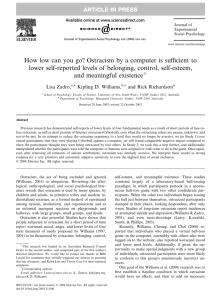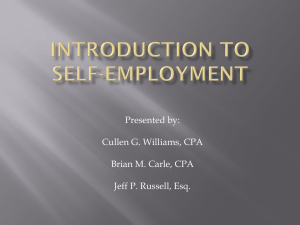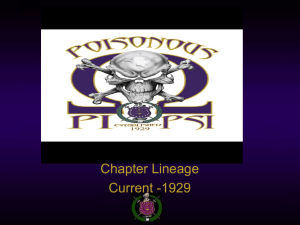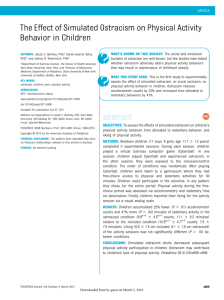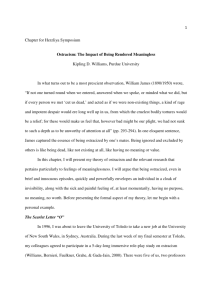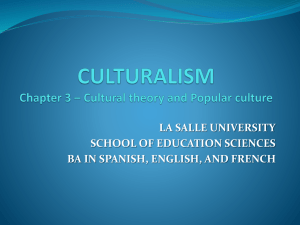Do ostracize people ostracize
advertisement
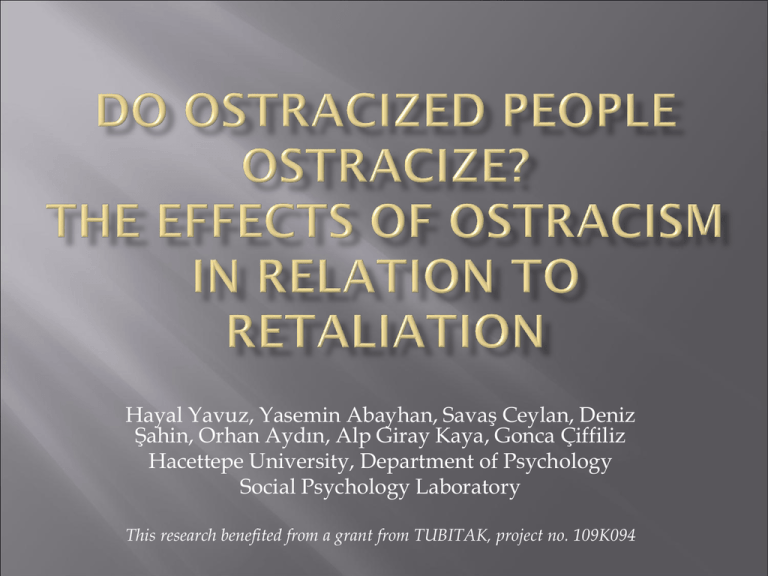
Hayal Yavuz, Yasemin Abayhan, Savaş Ceylan, Deniz Şahin, Orhan Aydın, Alp Giray Kaya, Gonca Çiffiliz Hacettepe University, Department of Psychology Social Psychology Laboratory This research benefited from a grant from TUBITAK, project no. 109K094 Ostracism, refers to being ignored, excluded and/or rejected by other individuals or groups independent of offering a justification or being a target of negative reactions (Williams, 2007). Because of the social nature of human, lack of social contact is stressful for human beings. Research had shown that ostracism evokes a variety of negative emotions such as sadness, anger and hostility as well as the experience of social pain (Chow, Tiedens & Govan,2008; DeWall et al., 2009; Eisenberger, Lieberman & Willams, 2003; Twenge et al., 2007). Chow, R.M., Tiedens, L.Z., & Govan, C. (2008). Excluded feelings: Emotional responses to social ostracism predict aggressive reactions. Journal of Experimental Social Psychology, 44, 896-903. DeWall, C.N., Twenge, J.M., Gitter, S.A.,& Baumeister, R.F. (2009). It’s the thought that counts: The role of hostile cognition in shaping aggressive responses to social exclusion. Journal of Personality and Social Psychology, 96(1), 45-59. Eisenberger, N.I., Lieberman, M.D., & Williams, K.D. (2003). Does rejection hurt: An Fmrı study of social exclusion. Science, 302, 290-292. Twenge, J.M., Baumeister, R.F., DeWall, N.C., Ciarocco, N.J., Bartels, M.J. (2007). Social exclusion decreases prosocial behavior. Journal of Personality and Social Psychology, 92(1), 56-66. Williams, K.D. (2007). Ostracism. Annual Review of Psychology, 58, 425-452 According to Need Threat Model (Williams, 1997); ostracism threatenes four fundamental needs; -self-esteem, -belongingness, -perceived control -meaningful existence Therefore, individuals act to fortify or replenish their thwarted needs by antisocial behaviors such as aggression, bullying, counter productive actions and violent acts or prosocial behaviors like cooperation, helping and organizational citizenship (Twenge, 2005; Williams, 2007). Twenge, J.M. (2005). When does social rejection lead to aggression? The influence of situations, narcissicm, emotion, and replenishing connections. In K.D. Williams, J.P. Forgas, & W.von Hippel (Eds.). The social outcast: Ostracism, social exclusion, rejection and bulyyinu. (pp.201-212). New York: Psychology Press. Williams, K.D. (1997). Social ostracism. R.M. Kowalski (Ed.), Aversive interpersonal behaviors içinde (s. 133-170). New York: Plenum. Williams, K.D. (2007). Ostracism. Annual Review of Psychology, 58, 425-452 The current study investigates the behavioral and emotional responses of ostracized people according to their self reports and their retaliation or helping behaviors by using both Cyberball and Brainstorming Paradigm. Participants -49 volunteer students; 7 of them Guessed the purpose of the study 5 of them Didn’t understand the manipulation 1 of them Knows our confederates personally Therefore; 36 participants (18 m; 18 f) -In brainstorming session, participants accompanied by three confederates. Confederates were instructed about how to behave in a week long training. - Dependent Variables Behavioral responses of participants (scored by judges on observational form; 36 possible behaviors were listed on the form such as “reminds the rules of brainstorming to the ostracizer” or “stop writing” etc.) - Emotional responses (self-report- Positive and Negative Affect Schedule (PANAS), Watson, Clark, & Tellegen, 1988). - Need threats (self report- Need Threat Scale, Van Beest & Williams, 2006). a) b) Procedure 2 disjoint studies Cover story of Cyberball: Participants were told that the goals of the research were to understand mental visualization and they would play an online game of toss with three other participants. Cyberball: The cyberball paradigm used in this study for ostracize the participants. c) Cover story of Brainstorming: -Brainstorming sessions for generating ideas. -4 different people from Hacettepe University. -Brainstorming rules. d) Brainstorming: -Ostracize one of the confederates. -Confederate try to speak with them and complain about the situation. a) Manipulation Checks of the Study Manipulation Checks of Cyberball: Conditions What percentage of throws do you think you received during the Cyberball game? Ostracism Inclusion F(1, 35)= 34.52, p <.0001, ² = .51 9.17 (3.03) 34.71 (3.12) b) Manipulation Checks of Brainstorming: Debriefing questions a) - Effects of ostrasicm on dependent variables Effects of ostrasicm on emotional responses: Cronbach alpha coefficients for both positive and negative emotions. Emotion type Cronbach Alpha Coefficients Positive Emotions .63 Negative Emotions .85 There were no significant main effects of ostracism on both negative and positive emotions, F (1, 36) = .73, p>.05, ² = .08. b) Effects of ostrasicm on need threat scale: -Cronbach’s alpha coefficients for each need; Need Cronbach’s Alpha Coefficient Belonging .69 Control .60 Self-esteem .81 Meaningful Existence .79 There were no significant main effects of ostracism on need threats, F(1, 36) = .91, p> .05, ² = .10. Effects of ostrasicm on behavioral responses: Behavior Mean Rank Z Ostracism Control Ignores the ostracizer 16,45 20,79 -1.91* Approves the ostracized’s complaints by nodding 21,53 15,12 -2,28** Bending his/her head 15,89 21,41 -2.09** Shows the paper to the ostracizer by pen or finger 22,26 14,29 -2.62*** *p < .06; **p < .05; ***p < .01 According to ostracism literature being ostracized had an effect on emotional responses and four fundamental needs (Smith & Williams, 2004;Williams, Cheung & Choi, 2000; Zadro, Williams & Richardson, 2004,). The current study suggests that being ostracized doesn’t change the participants emotional responses and doesn’t threat their four fundamental needs. Smith, A., & Williams, K. D. (2004). R U There? Effects of ostracism by cell phone messages. Group Dynamics: Theory, Research, and Practice, 8, 291-301. Williams, K. D., Cheung, C. K. T., & Choi, W. (2000).CyberOstracism: Effects of being ignored over the Internet.Journal of Personality and Social Psychology, 79, 748-762. Zadro, L., Williams, K. D., & Richardson, R. (2004). How low can you go? Ostracism by a computer lowersbelonging, control, self-esteem, and meaningful existence. Journal of Experimental Social Psychology, 40,560-567. The participants who are ostracized in cyberball sessions are much more sensitive to the cues of ostracism. Therefore they try to ignore the ostracizer less frequently than the participants in the control condition and even emphatize the ostracized confederates by approving their complains. They are actively try to intervene the situation by points the paper to the ostracizer by pen or finger. Limitations: We need to collect data on noostracism brainstorming sessions. And some of our measures may need to be revised due to cronbach alpha’s coefficients lower than .70.
